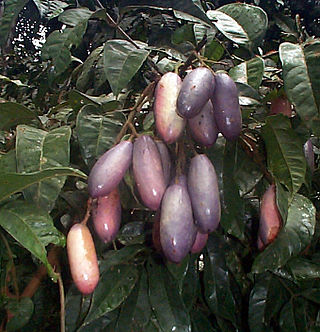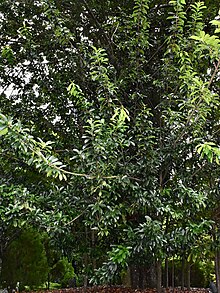
Vitellaria paradoxa, commonly known as shea tree, shi tree, or vitellaria, is a tree of the family Sapotaceae. It is the only species in the genus Vitellaria, and is indigenous to Africa.

The African grey woodpecker is a species of bird in the woodpecker family Picidae. Is a widespread and frequently common resident breeder in much of Sub-Saharan and equatorial Africa. It is a species associated with forest and bush which nests in a tree hole, often in an oil palm, laying two to four eggs. It is a common bird with a very wide range, and the International Union for Conservation of Nature has rated its conservation status as being of "least concern".

The Sapotaceae are a family of flowering plants belonging to the order Ericales. The family includes about 800 species of evergreen trees and shrubs in around 65 genera. Their distribution is pantropical.

Shea butter is a fat extracted from the nut of the African shea tree. It is ivory in color when raw and commonly dyed yellow with borututu root or palm oil. It is widely used in cosmetics as a moisturizer, salve or lotion. Shea butter is edible and is used in food preparation in some African countries. Occasionally, shea butter is mixed with other oils as a substitute for cocoa butter, although the taste is noticeably different.
Discoglypremna is a plant genus of the family Euphorbiaceae first described as a genus in 1911. It contains only one known species, Discoglypremna caloneura, native to tropical Africa.

Goliathus regius, the Royal Goliath beetle, is a species of beetles of the family Scarabaeidae.

Dacryodes edulis is a fruit tree in the Burseraceae family native to Africa. Its various regional names include safou, plum (Cameroon), atanga, ube, elumi (Nigeria), African pear, bush pear, African plum, nsafu, bush butter tree, or butterfruit.

Marula oil is extracted from the kernels (nuts) of the fruits of the Marula tree, from the family Anacardiaceae. There are two types of marula oil, the oil extracted from the seeds and the oil extracted from the nut's hard shell. Marula oil is traditionally used in cosmetics, in food as a cooking oil and meat preservative and to treat leather. Marula oil can also be used as body lotion. In Namibia Marula fruit is processed into a range of juices, jellies and jams.

Afzelia africana, the African mahogany, afzelia, lenke, lengue, apa, or doussi, is a tree species in the family Fabaceae.

Benin is predominantly a rural society, and agriculture in Benin supports more than 70% of the population. Agriculture contributes around 35% of the country's gross domestic product (GDP) and 80% of export income. While the Government of Benin (GOB) aims to diversify its agricultural production, Benin remains underdeveloped, and its economy is underpinned by subsistence agriculture. Approximately 93% of total agricultural production goes into food production. The proportion of the population living in poverty is about 35.2%, with more rural households in poverty (38.4%) than urban households (29.8%). 36% of households depend solely upon agricultural (crop) production for income, and another 30% depend on crop production, livestock, or fishing for income.
Benin is a coastal country located in the Gulf of Guinea in Western Africa, which is a resource rich region. Energy in Benin has a diverse energy mix and takes several forms including: solar, wind, hydropower, biomass, fossil resources, and mineral resources. Out of this energy mix, about 60% of energy comes from biomass. Benin is also dependent on energy imports from Ghana and Côte d'Ivoire. While power plants and other energy facilities were built in the 1950s and 1960s, the lack of investment has led to deterioration over time. Similarly, its location in the Gulf of Guinea has led to an attempt of oil production starting in the late 1980s. However, due to unprofitable operations, oil production halted in 1998.

Vitellaria paradoxa is extremely important in Burkina Faso. Termed "women's gold" by Burkinabé villagers, the nuts of shea tree can be collected and processed by crushing and grinding to yield shea butter, which is widely used in soap and in cosmetics as a moisturizer, salve, or lotion. Shea butter is also edible and may be used in food preparation; it is sometimes used in the manufacture of chocolate. The bark of the tree is also used as an ingredient in traditional medicines and the shell of nut is said to be able to repel mosquitoes and is also said to protect existing trees.
Around the world, journalists who report on environmental problems such as deforestation, pollution and climate change, are forming networks and associations. The largest of these—the Society of Environmental Journalists in the United States—was formed in 1990 and has over 1400 members. Since then, journalists have formed new networks in Africa, Asia and other regions. These activities that these groups undertake include training programmes, advice to journalists, and advocacy to raise the prominence of environmental topics in the media. In Africa and Asia, these networks also act to raise funds to support better quality reporting on environmental issues. James Fahn, director of the Earth Journalism Network, notes however that donors generally seem less willing to support these journalism associations than they do environmental advocacy groups.

Dialium guineense, the velvet tamarind, is a tall, tropical, fruit-bearing tree in the flowering plant family Fabaceae. It has small, typically grape-sized, edible fruits with brown, hard, inedible shells.

Phulwara oil is extracted from seeds of Phulwara tree. Phulwara Trees are also known locally as Chiuri Trees, Kaeleb Trees, or Butter Nut Trees. Refined Phulwara Oil is marketed as Phulwara Ghee.
The West African Bankers' Association is a professional association of banking and financial services and institutions in West Africa.
Allanblackia oil is a vegetable oil that comes from the seeds of trees of the genus Allanblackia. This tree can be found in the wet tropical belt of Africa. Because of its unique blend of fatty acids, the oil from Allanblackia seeds has melting properties that make it excellent to use as structuring fat in food products, e.g. margarines.

Raphia farinifera is a tropical African palm tree occurring in lowland riparian and swamp forest, also around human habitations and cultivated locations, on stream banks and other moist situations at altitudes of 50–1000 m. Found in Angola, Benin, Burkina, Cameroon, Gambia, Ghana, Guinea, Ivory Coast, Kenya, Madagascar, Malawi, Mauritius, Mozambique, Nigeria, Réunion, Senegal, Seychelles, Sierra Leone, Tanzania, Togo, Uganda, Zambia and Zimbabwe, and naturalised in east lowlands of Madagascar. Its generic epithet is derived from raphis = 'needle', probably in reference to the 4 mm long yellowish spines on the margins and main veins of the leaflets. The specific name refers to a type of starchy flour obtained from the trunk pith – farina = 'starch', fera = 'bearing'.
The Guineo-Congolian region is a biogeographical region in Africa straddling the Equator and stretching from the Atlantic Ocean through the Congo Basin to the Congo / Nile divide in Rwanda and Burundi. Formerly, this region was largely covered in rain forest, on both well-drained sites and in swamp forests, but little undisturbed primary forest now remains, having been replaced in many areas by savanna and secondary-growth forest.

Trachylepis perrotetii, also known commonly as the African red-sided skink, the red-sided skink, and the Teita mabuya, is a species of lizard in the family Scincidae. The species is endemic to Africa.













